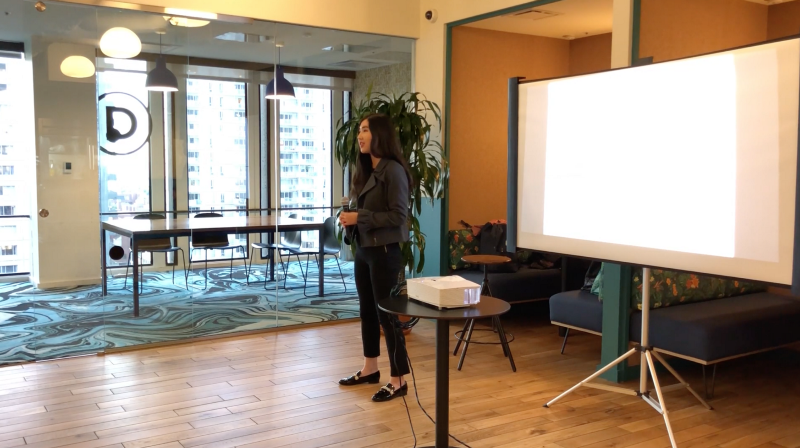by Tiffany Eaton
What I Learned Giving My First Talk as a Woman In Tech

I have become greatly passionate in expanding the way I help other designers achieve their personal goals in their careers. The passion to empower and evangelize UX has manifested into different forms, such as talking in my first podcast, discussion, and curating my own class.
This past month, I decided to give my first “public” talk outside of school. The support and opportunity came from Women Talk Design.
Women Talk Design is a platform that elevates talks by women and non-binary individuals. They enpower event organizers with tools, approaches, and information to engage more diverse speakers.
The founder of this initiative is Christina Wodtke, an amazing teacher and mentor to me during school and my career. Her strong personality, amazing experience, ability to overcome hardship, and take anything she is given into tangible value has given me courage to unapologetically pursue whatever I want. She’s given me the belief that if I put my mind towards something, with intention and perseverance, I can do anything.
I deeply believe one of the more effective ways of calling people to action is through compelling storytelling. Giving public talks in the form of crafting stories is a skill inherent in the whole field of UX design and a skill that is deeply valuable to me and my goal of helping others.
In this article, I’ll be covering what I learned from giving my first talk.
Preparing a talk in a way that works for me

The process of giving my first talk allowed me to understand how to create future talks. Firstly, there are constraints you might need to consider. Because the event required us to give a lighting talk that could only be 5 minutes max, I had to be concise with the information leading up to my message. I could only include the most necessary information that most supported my talk.
So you need to decide: what is the message you want to convey?
Constraints allowed me to be realistic with my speech objectives. The way I prepared my talk was first writing it out and then practicing it to eliminate parts that that didn’t flow well when I spoke. This made it easier to minimize redundancies and focus on parts that were important to identify if I was giving a longer talk, but didn’t contribute any additional value to my message.
From experience, every talk has a lesson or steps of action one can take which connect to the lesson. I found that a good way to start constructing a talk is having a central message and creating points around it. Those could be experiences that connect or prove your message, statistics, conflict and resolutions, a memorable incident, and so on.
Here is a good article by Christina Wodtke about how to craft a good talk and the importance of story.
People want to listen to you

When I was speaking, I found that everyone in the room was very supportive and focused their attention on me. This gave me more encouragement to comfortably and confidently give my talk.
Whenever you give a speech, people are going to listen. That’s why they are there in the first place. They want to learn from your experiences. Giving talks can be super high stress and high stakes because of the amount of pressure it can put on you. But you shouldn’t think about it like that. For the most part, people want you to succeed. They want to hear about your journey.
Incorporating stories in speeches is important, because it is what allows people to empathize, relate, and be more engaged with what you have to say. I found speaking empowering in this aspect, because I knew that people wanted me to succeed in giving the talk. And I also wanted to teach them something new and inspire them.
Everyone has a story to tell

Stories are powerful. They allow us to share our experiences in relatable ways and have a profound impact on our audience. At the event, I had the opportunity to hear talks from other speakers. It was amazing to hear their stories.
Though there were some experiences I haven’t gone through, it was eye-opening to hear women talk about them in a way that made me feel like I was a part of their journey. All the talks I listened to taught me something new or validated things that I could connect to my life.
If you feel like you have nothing to say, you are lying to yourself. There are definitely stories you have which are worth sharing, and everyone loves stories. You just need to find your message or a personal story that is super important to you.
Speaking is an iterative process

I was constantly revising my talk, from how I was going to draw the audience in to the central message I wanted the audience to remember most. I found that presenting to my classmates or random people was really helpful, because it allowed me to understand how people received my message. I got helpful feedback on parts of my talks that didn’t make sense, when to take pauses rather than speaking super fast, smiling, and tone of voice. This allowed me to strengthen my talk and develop better practices moving forward.
I learned that there is no such thing as a “perfect” talk. There is always going to be something you will want to improve on, especially for the small things like emphasizing a certain part of the talk or a time when you wanted to say more.
For me, I try to worry less about the small details but rather about the overall execution. I believe that a talk is successful if I am able to convey my message confidently and spark discussion. If people are able to leave with something valuable that they can apply to their life, I feel successful.
Practice

Practicing allowed me talk more comfortably and confidently in front of an audience without stressing too much about what people think of me. And you shouldn’t care too much anyway, because you can’t please everyone. I believe that being over-prepared is better than being under-prepared, because it shows that you care and are willing to go above and beyond in your work.
I believe the amount of practice you put in will make your message that much more powerful. In my case, practicing a few times every week for the 3–4 weeks before the talk made me more comfortable to give talks in the future.
Besides practicing in front of people and in a mirror, I watched TED talks. Watching and gaining inspiration from TED talks and other women speakers allowed me to pick up and observe how they were communicating with hand motions, intonation, and projection. They also were a great inspiration to tell my story and not give up when I didn’t believe I could successfully give my talk.
Conclusion
A few years ago, I would have never considered myself speaking in a public event. But my calling to communicate deeply with people and empower them through the work I do is something that drives me. I want to continue reaching out to others, and this means getting out of my comfort zone to challenge myself in doing so.
Women Talk Design is great because it provides a safe space for women to practice and give talks. It is a wonderful, supportive network where everyone gives each other the confidence and encouragement to pursue their passions and ultimately help each other. If we want to balance the gender gap and have more equal representation, we need to be more involved in tech events and get our voices out there. We need to inspire the next generation of girls and empower them to challenge existing gender norms of what it means to be a woman.
I’m inspired by women who have the courage to stand on stage and tell their stories. Often times, they have faced adversity, whether in their personal lives or the workforce. They’ve often overcome hardships and challenged societal norms. Their stories are empowering in showing that they can be strong and just as successful as men.
Check out my Skillshare Course on UX Research and learn something new!
To help you get started on owning your design career, here are some amazing tools from Rookieup, a site I used to get mentorship from senior designers.
- Build a portfolio with help from an experienced designer
- Essential tools to strengthen and build your portfolio
Links to some other cool reads: